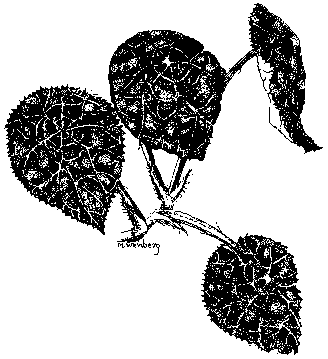B. goegoensis was discovered in Goego, Sumatra. It was introduced in 1881, and first described in 1882 by N. E. Brown. It is in section Reichheimaia, and has 34 chromosomes.
B. goegoensis is a rhizomatous begonias with distinctive foliage. Leaves are egg-shaped, tapering to a point, peltate, and silky dark green-bronze in color. The undersides and edges of the leaves are dull red, with sparse red hairs on the edges and on the veins, giving the leaves a heavily quilted appearance. The main stem is short, creeping, with very short internodes. Stipules are ovate-acuminate, tinted with red, and have red hairs on the edges and main rib. Petioles are four-sided, giving a very distinctive square look, and are light green tinted with red. Flowers are small and rose pink in color; staminate flowers have four tepals and pistillate flowers five tepals. The ovary is pink with unequal wings. B. goegoensis is a moderate bloomer through summer and fall.
According to the Encyclopedia Britannica, Sumatra has an annual rainfall of 80 to 120 inches, giving it a very humid atmosphere. Temperatures range between 57 and 80 degrees. Along the west coast the country is very mountainous, with the east coast consisting of mangrove swamps and bogs. The soil has marginal degrees of fertility, consisting for the most part of decomposed rock. It is a very active volcanic area.
B. goegoensis was one of the earliest begonias I collected. Due to my overly protective nature, I managed to kill it shortly after purchasing it. I drenched it with water and kept it well covered with a plastic baggy, and did not heed its calls for help as it was drowning in my tender loving care.
A few years later the Seed Fund offered seed of B. goegoensis. I ordered a packet, and after planting got 100% germination. I keep the seedlings in the light garden, and as they got larger I removed their protective cover (humidity in my light garden is about 50%). I placed one of the larger plants in a small terrarium, using sphagnum moss and perlite for the growing medium. It was transferred once to a larger terrarium when it grew too big for its small home.
One spring I decided to grow B. goegoensis in a pot to see if it would survive in my home. In order to remove the plant from the terrarium to the outside air without the change in atmosphere damaging its leaves, I started by removing the terrarium cover slowly, a little each day, until it was fully exposed to room air. Then I carefully lifted the plant out of the moss, removing as much as possible from the roots so as not to damage them. Using my standard growing medium, to which I added leaf mold and a pinch of bone meal and more perlite, I potted goegoensis in a 4″ square plastic pot. It did very well in the house all summer. I placed it back in the light garden for the winter months, as the humidity there is much more to its liking.
CULTURE
Light: Provide a bright situation, about four hours of filtered sun. Do not expose to midday sun. In a light garden, give it a bright spot; this will keep the leaves from getting too dark.
Temperature: B. goegoensis like it on the warm side. A range of 70-75 degrees would be ideal. It tends to lose leaves in the winter if kept too cool.
Humidity: B. goegoensis does well in a terrarium, but can survive growing in a greenhouse or under house conditions if you can provide humidity in the 50-60% range.
Growing Medium: Pot in a light porous medium; add peat moss or leaf mold with a pinch of bone meal, as it likes a rich humusy growing medium.
Fertilizer: B. goegoensis should be fertilized on a regular basis during the growing season.


